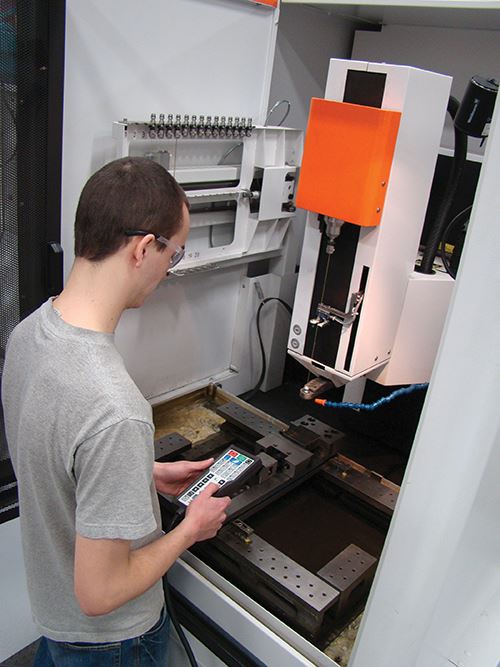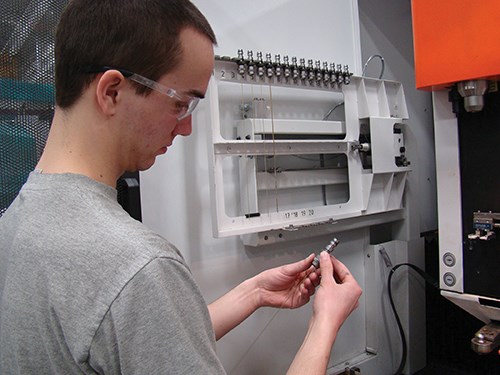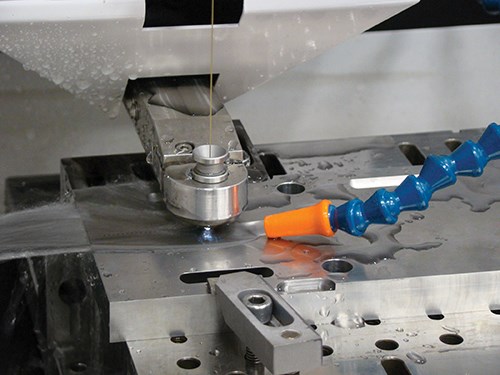EDM Drilling Unit Improves Production for Aerospace Manufacturer
This shop utilized a hole-drilling EDM to improve setup time, manage labor hours and provide faster turnaround.
Share





Small-hole EDM is a growing area of interest for KLH Industries (Germantown, Wisconsin). The company continues to gain traction in aerospace applications, particularly in aircraft engines, because of the various hole sizes and shapes that can be produced by today’s advanced equipment. KLH machines small and even potentially microscopic holes with the low machining force of EDM, in which an electrode never contacts the workpiece, helping to maintain straightness and concentricity.
Aerospace Focus
KLH is a precision parts manufacturer that specializes in EDM, CNC machining, waterjet cutting and contract inspection. The company has manufactured components for the International Space Station and is a machining supplier for the Boeing Space Launch System, a heavy-lift rocket capable of transporting crew and cargo beyond the moon and eventually to Mars. Additionally, it has produced components that aid in the guidance, navigation, control and communications of new and existing aerospace designs.
The “Hole” Problem
Today, multi-hole and multi-electrode operations have become the norm for KLH, says Davin Karvala, EDM business unit manager. However, an increase in these types of jobs meant the company had to find a way to drill the holes quicker. This was difficult because machine operators were manually changing the electrodes out of the older EDM equipment every hour on the hour, a process that took too much time, Mr. Karvala says. The operator would have to wait for the machine to consume the electrode and stop, unscrew the collet from the machine, remove the spent electrode, add a new electrode, screw the collet into the machine and continue drilling.
This process required KLH to dedicate an employee on every shift to stand in front of the machine and make sure it kept drilling. If the operator was unavailable to tend the machine when the electrode was finished, it could result in the machine being idle for several hours. Mr. Karvala knew there had to be a better solution.
Automated Electrode Changes
To expand the company’s EDM capabilities by making electrode changes quicker, KLH invested in the Drill 300 hole-drilling EDM from GF Machining Solutions (formerly GF AgieCharmilles) of Lincolnshire, Illinois. This equipment helped make significant improvements to setup time, managing labor hours and providing faster turnaround for KLH’s aerospace customers.
With the Drill 300, KLH operators now have a significantly faster and more effective solution to change electrodes. The Drill 300 is equipped with an automated electrode and guide changer that reduces setup time in an eight-hour shift down to just a few hours per day. The operator has the ability with this automation technology to load the electrode change once per shift, he says, freeing the operators to run other machines or start other jobs on the shop floor.
In addition to the reduced setup time, the efficiently controlled EDM processes on the new machine tool have led to faster throughput and less electrode wear. The machine’s breakthrough technology (related to when an electrode essentially “breaks through” the part to make the hole) has made it easier for the shop to manage the speed, consistency and precision requirements of its aerospace hole-making applications.
“We see a much slower rate of electrode wear than on other EDM equipment on the floor. There’s also less deviation in the hole diameter leading to a more consistent hole through the part,” Mr. Karvala says.
This is accomplished with the machine’s Intelligent Power Generator (IPG). The IPG optimizes each electrode pulse to reduce electrode wear or control surface finish. This process control takes a fraction of a second adjusting and modifying each electrode pulse.
This reduced setup time, in conjunction with the machine’s control over the EDM processes, have led to a 50 percent increase in hole-making productivity. One block might require 2,200 holes, while the next could have 700. KLH once drilled more than 5,000 holes in a block, so the production time can vary greatly for each application.
The software for the Drill 300 offers additional benefits, Mr. Karvala says. “The AC HMI Drill software enables our team to stop in the middle of a program, run a different job and then pick up right where they left off. It can provide holes with different diameters and positions in a single setup. KLH team members can make generator adjustments at the machine to optimize drilling. That data is stored locally and can be called up for similar applications.”
GF Machining Solutions provided several pre-settings that KLH operators could work with, but additional programs were needed to meet certain customer needs. For example, the program couldn’t initially accommodate an application that required thousands of holes drilled into a 5-inch-thick piece of aluminum. Therefore, KLH tested and developed its own job program parameters for a component of that size and worked with engineers at GF Machining Solutions to ensure that the software was capable of handling a large quantity of holes like this in the future.
Mr. Karvala says the company has already drilled about 160,000 holes with the new machine. It was originally intended to complement its other EDMs, but has quickly become a stand-alone service that increased drilling capabilities, particularly in aerospace applications. He says that adding this machine has enabled KLH to become much more competitive in pricing due to the reduction in labor hours and the faster turnaround for parts. The plan is to invest in additional small-hole EDM equipment in the near future.
“If there’s work, we’ll continue to make the machine tool investment,” Mr. Karvala explains. “Perhaps we’ll invest in a machine with additional electrode capacity that can run over the weekend without any operator intervention.”
Related Content
Tungaloy Drills, Milling Inserts Provide Enhanced Stability
Tungaloy has expanded its DrillForceMeister and TecMill lines with new drill bodies and milling inserts.
Read MoreCeratizit Product Update Enhances Cutting Tool Solutions
The company has updated its MaxiMill 273-08 face mill, WPC – Change Drill, as well as the HyPower Rough and HyPower Access 4.5-degree hydraulic chucks.
Read MoreFinding the Right Tools for a Turning Shop
Xcelicut is a startup shop that has grown thanks to the right machines, cutting tools, grants and other resources.
Read MoreForm Tapping Improves Tool Life, Costs
Moving from cut tapping to form tapping for a notable application cut tooling costs at Siemens Energy and increased tool life a hundredfold.
Read MoreRead Next
Registration Now Open for the Precision Machining Technology Show (PMTS) 2025
The precision machining industry’s premier event returns to Cleveland, OH, April 1-3.
Read MoreBuilding Out a Foundation for Student Machinists
Autodesk and Haas have teamed up to produce an introductory course for students that covers the basics of CAD, CAM and CNC while providing them with a portfolio part.
Read More5 Rules of Thumb for Buying CNC Machine Tools
Use these tips to carefully plan your machine tool purchases and to avoid regretting your decision later.
Read More























.jpg;maxWidth=300;quality=90)













